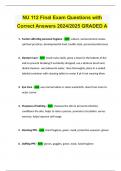NU 112 Final Exam Questions with
Correct Answers 2024/2025 GRADED A
1. Factors affecting personal hygiene - ANS -culture, socioeconomic status,
spiritual practices, developmental level, health state, personal preferences
2. Denture Care - ANS -brush twice daily, place a towel in the bottom of the
sink to prevent breaking if accidently dropped, use a denture brush and
dental cleanser, use lukewarm water, rinse thoroughly, place in a sealed
labeled container with cleaning tablet or water if pt it not wearing them
3. Eye Care - ANS -use normal saline or clean washcloth, clean from inner to
outer corner
4. Purposes of bathing - ANS -cleanses the skin & prevents infection,
conditions the skin, helps to relax a person, promotes circulation, serves
exercise, helps improve self image
5. Donning PPE - ANS -hand hygiene, gown, mask, protective eyewear, gloves
6. Doffing PPE - ANS -gloves, goggles, gown, mask, hand hygiene
,7. When should you assess vital signs? - ANS -on admission to health care
facility, change in condition, before and after any surgical or invasive
procedure, before and after activity that may increase risk, before meds
that affect respiratory and CV functions
8. Methods of assessing temperature - ANS -oral, temporal, tympanic, rectal,
axillary
9. Assessing tympanic temperature in adults - ANS -pull pinna (outer part of
ear) up and back
10.Assessing tympanic temperature in children 3 and under - ANS -pull pinna
back and downward
11.Factors that affect body temperature - ANS -age, hormone level
environmental, exercise, circadian rhythm, temperature alterations
12.Blood Pressure Cuff Size Rule - ANS -40/80 rule
, 13.Antihypertensive Medications - ANS -diuretics, beta adrenergic blockers,
vasodilators, calcium channel blockers, ACE inhibitors
14.Normal Vital Sign Ranges for Healthy Adults - ANS -Oral temp- 98.6
Pulse- 60-100
Respirations- 12-20
Blood pressure- 120/80
oxygen saturation- 95-100% on room air
15.Factors that affect vital signs - ANS -age, biologic sex, physical activity,
stress, body temperature, medications, underlying diseases or health
conditions, food intake, emotional state, drugs and alcohol
16.Sites to assess pulse - ANS -temporal, carotid, brachial, radial, femoral,
popliteal, posterior tibialis, dorsalis pedis
17.Types of health assessment - ANS -initial comprehensive assessment,
ongoing/ partial, focused/ problem, emergency
18.Steps of health assessment - ANS -collection of data, validate data,
document data




